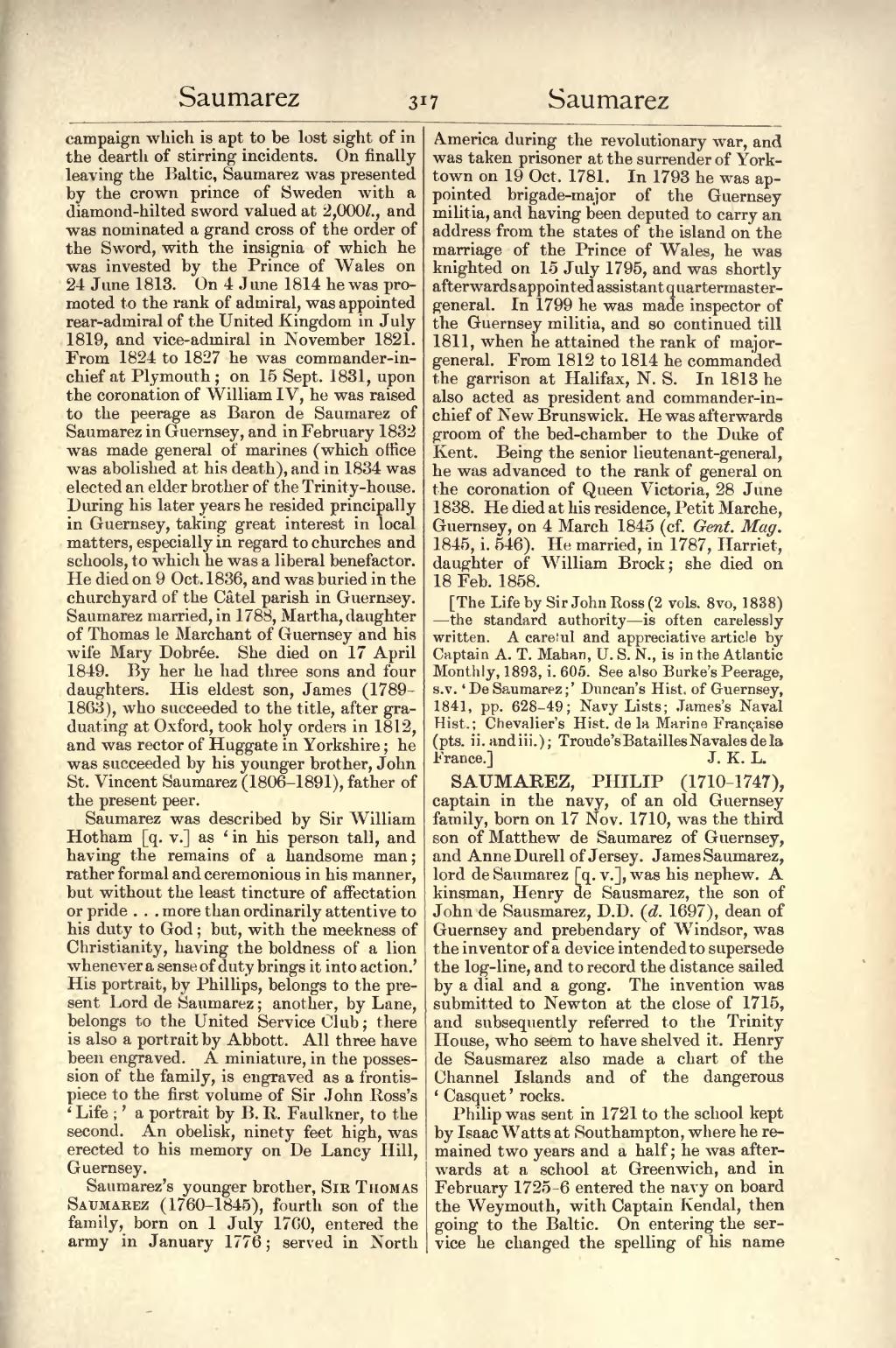campaign which is apt to be lost sight of in the dearth of stirring incidents. On finally leaving the Baltic, Saumarez was presented by the crown prince of Sweden with a diamond-hilted sword valued at 2,000l., and was nominated a grand cross of the order of the Sword, with the insignia of which he was invested by the Prince of Wales on 24 June 1813. On 4 June 1814 he was promoted to the rank of admiral, was appointed rear-admiral of the United Kingdom in July 1819, and vice-admiral in November 1821. From 1824 to 1827 he was commander-in-chief at Plymouth; on 15 Sept. 1831, upon the coronation of William IV, he was raised to the peerage as Baron de Saumarez of Saumarez in Guernsey, and in February 1832 was made general of marines (which office was abolished at his death), and in 1834 was elected an elder brother of the Trinity-house. During his later years he resided principally in Guernsey, taking great interest in local matters, especially in regard to churches and schools, to which he was a liberal benefactor. He died on 9 Oct. 1836, and was buried in the churchyard of the Câtel parish in Guernsey. Saumarez married, in 1788, Martha, daughter of Thomas le Marchant of Guernsey and his wife Mary Dobrée. She died on 17 April 1849. By her he had three sons and four daughters. His eldest son, James (1789–1863), who succeeded to the title, after graduating at Oxford, took holy orders in 1812, and was rector of Huggate in Yorkshire; he was succeeded by his younger brother, John St. Vincent Saumarez (1806–1891), father of the present peer.
Saumarez was described by Sir William Hotham [q. v.] as ‘in his person tall, and having the remains of a handsome man; rather formal and ceremonious in his manner, but without the least tincture of affectation or pride … more than ordinarily attentive to his duty to God; but, with the meekness of Christianity, having the boldness of a lion whenever a sense of duty brings it into action.’ His portrait, by Phillips, belongs to the present Lord de Saumarez; another, by Lane, belongs to the United Service Club; there is also a portrait by Abbott. All three have been engraved. A miniature, in the possession of the family, is engraved as a frontispiece to the first volume of Sir John Ross's ‘Life;’ a portrait by B. R. Faulkner, to the second. An obelisk, ninety feet high, was erected to his memory on De Lancy Hill, Guernsey.
Saumarez's younger brother, Sir Thomas Saumarez (1760–1845), fourth son of the family, born on 1 July 1760, entered the army in January 1776; served in North America during the revolutionary war, and was taken prisoner at the surrender of Yorktown on 19 Oct. 1781. In 1793 he was appointed brigade-major of the Guernsey militia, and having been deputed to carry an address from the states of the island on the marriage of the Prince of Wales, he was knighted on 15 July 1795, and was shortly afterwards appointed assistant quartermaster-general. In 1799 he was made inspector of the Guernsey militia, and so continued till 1811, when he attained the rank of major-general. From 1812 to 1814 he commanded the garrison at Halifax, N. S. In 1813 he also acted as president and commander-in-chief of New Brunswick. He was afterwards groom of the bed-chamber to the Duke of Kent. Being the senior lieutenant-general, he was advanced to the rank of general on the coronation of Queen Victoria, 28 June 1838. He died at his residence, Petit Marche, Guernsey, on 4 March 1845 (cf. Gent. Mag. 1845, i. 546). He married, in 1787, Harriet, daughter of William Brock; she died on 18 Feb. 1858.
[The Life by Sir John Ross (2 vols. 8vo, 1838)—the standard authority—is often carelessly written. A careful and appreciative article by Captain A. T. Mahan, U. S. N., is in the Atlantic Monthly, 1893, i. 605. See also Burke's Peerage, s.v. ‘De Saumarez;’ Duncan's Hist. of Guernsey, 1841, pp. 628–49; Navy Lists; James's Naval Hist.; Chevalier's Hist. de la Marine Française (pts. ii. and iii.); Troude's Batailles Navales de la France.]
SAUMAREZ, PHILIP (1710–1747), captain in the navy, of an old Guernsey family, born on 17 Nov. 1710, was the third son of Matthew de Saumarez of Guernsey, and Anne Durell of Jersey. James Saumarez, lord de Saumarez [q. v.], was his nephew. A kinsman, Henry de Sausmarez, the son of John de Sausmarez, D.D. (d. 1697), dean of Guernsey and prebendary of Windsor, was the inventor of a device intended to supersede the log-line, and to record the distance sailed by a dial and a gong. The invention was submitted to Newton at the close of 1715, and subsequently referred to the Trinity House, who seem to have shelved it. Henry de Sausmarez also made a chart of the Channel Islands and of the dangerous ‘Casquet’ rocks.
Philip was sent in 1721 to the school kept by Isaac Watts at Southampton, where he remained two years and a half; he was afterwards at a school at Greenwich, and in February 1725–6 entered the navy on board the Weymouth, with Captain Kendal, then going to the Baltic. On entering the service he changed the spelling of his name
